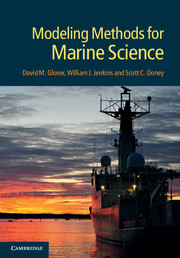Book contents
- Frontmatter
- Contents
- Preface
- 1 Resources, MATLAB primer, and introduction to linear algebra
- 2 Measurement theory, probability distributions, error propagation and analysis
- 3 Least squares and regression techniques, goodness of fit and tests, and nonlinear least squares techniques
- 4 Principal component and factor analysis
- 5 Sequence analysis I: uniform series, cross- and autocorrelation, and Fourier transforms
- 6 Sequence analysis II: optimal filtering and spectral analysis
- 7 Gridding, objective mapping, and kriging
- 8 Integration of ODEs and 0D (box) models
- 9 A model building tutorial
- 10 Model analysis and optimization
- 11 Advection–diffusion equations and turbulence
- 12 Finite difference techniques
- 13 Open ocean 1D advection–diffusion models
- 14 One-dimensional models in sedimentary systems
- 15 Upper ocean 1D seasonal models
- 16 Two-dimensional gyre models
- 17 Three-dimensional general circulation models (GCMs)
- 18 Inverse methods and assimilation techniques
- 19 Scientific visualization
- Appendix A Hints and tricks
- References
- Index
19 - Scientific visualization
Published online by Cambridge University Press: 05 June 2012
- Frontmatter
- Contents
- Preface
- 1 Resources, MATLAB primer, and introduction to linear algebra
- 2 Measurement theory, probability distributions, error propagation and analysis
- 3 Least squares and regression techniques, goodness of fit and tests, and nonlinear least squares techniques
- 4 Principal component and factor analysis
- 5 Sequence analysis I: uniform series, cross- and autocorrelation, and Fourier transforms
- 6 Sequence analysis II: optimal filtering and spectral analysis
- 7 Gridding, objective mapping, and kriging
- 8 Integration of ODEs and 0D (box) models
- 9 A model building tutorial
- 10 Model analysis and optimization
- 11 Advection–diffusion equations and turbulence
- 12 Finite difference techniques
- 13 Open ocean 1D advection–diffusion models
- 14 One-dimensional models in sedimentary systems
- 15 Upper ocean 1D seasonal models
- 16 Two-dimensional gyre models
- 17 Three-dimensional general circulation models (GCMs)
- 18 Inverse methods and assimilation techniques
- 19 Scientific visualization
- Appendix A Hints and tricks
- References
- Index
Summary
It's not what you look at that matters, it's what you see.
Henry David ThoreauWhy scientific visualization?
Throughout this book we have used a number of MATLAB's graphical capabilities as tools to monitor the progression of our mathematical and numerical travails, to demonstrate some characteristic of our results, or to reveal underlying relationships in data. Our emphasis now will be on the basic process of scientific visualization and providing you with some advice on how to effectively use (and not abuse) the many tools available to you. You may think that scientific visualization is an easy and natural thing to do, especially given the relatively powerful and reasonably intuitive tools built into MATLAB and other “point and click” packages so readily available. However, in the many years that we have been attending conferences, reading journals, and perusing text-books, we have encountered some ghastly instances of computer graphics abuse (or more to the point, abuse of the poor viewer/reader). This is a shame, because invariably the presenter has worked hard, often under difficult circumstances, to acquire scientific data, execute a model, or discover an erstwhile hidden relationship … only to fail to communicate the final result effectively. After all, isn't communication the final end-product of all our scientific endeavors?
We could also regale you with the awe-inspiring size of today's huge data sets, but rest assured that tomorrow's will be even more impressive.
- Type
- Chapter
- Information
- Modeling Methods for Marine Science , pp. 516 - 536Publisher: Cambridge University PressPrint publication year: 2011



